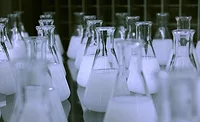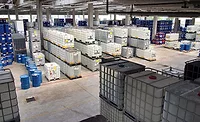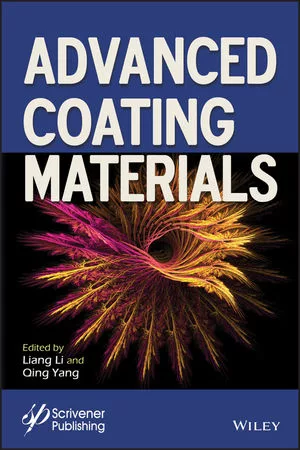Advanced Pigging Technologies
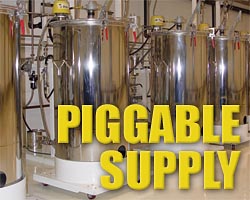
The use of piggable paint circulation systems in North America has steadily increased in recent years. A piggable paint circulation system uses piping of constant diameter, commonly known as a one-pipe system, through which a pig, or tight-fitting flexible plug, is pushed to both recover the paint in the line and to provide a preliminary mechanical cleaning of the piping prior to the use of solvents. The use of a pig can reduce paint losses and solvent usage during color change cycles. Traditionally, a pig has been a simple foam plug forced through the piping by compressed air. Pigs of this type are commonly used just once, and the insertion and removal of the pig, as well as the entire color changing process, are typically fully manual operations. The use of traditional pigging technology as part of the paint circulation line color change process is therefore usually messy, time consuming and labor intensive.
The paint finishing market in Europe has seen the recent development of technologies that push the basic pigging concept into new areas of use and to far greater levels of sophistication. This article reviews three advanced pigging technology applications that are coming into widespread use in Europe and are now gaining notice in North America.
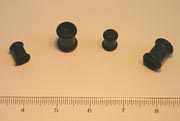
Paint Circulation Systems Pigging
A critical advance in the use of pigs in paint circulation systems has been the development of the permanent pig. A permanent pig is molded of a suitably flexible and solvent-resistant rubber-like material. Its shape is best described as a cylindrical squeegee, with two or more circular raised rings around its circumference. Pigs of this type are designed to stay in the paint circulation systems and can be used for scores, and often hundreds, of pigging cycles. With the elimination of the need to manually insert and remove a single-use pig for each color change cycle of a paint circulation line, it becomes possible to fully automate the process of paint push out, piping cleaning, and preparation for the next color. Automatic pigging systems have "pig launcher" and "pig receiver" stations built into the piping systems. During normal operation, the pig is nestled in the pig launcher, where the configuration of the internal passages allows the paint to bypass the pig. At the initiation of a pigging cycle, internal valves in the launcher inject the pig into the paint circulation piping, where it is pushed along by compressed air and/or solvent. Automatic valves at the other end of the line allow the paint remaining in the line to be pushed back into the paint supply container. When the pig reaches the receiver, which is usually back at the pump station, various valves open and close, and the pig is pushed back toward the launcher. After one or two such cycles, the bulk of the paint in the line has been recovered, the line has been cleaned with solvent and air, and it is ready to receive the next color. This process can be fully automatic. Paint is returned to its container, solvent is injected from a supply line, and waste is diverted to a dump without manual intervention. In some systems, the level of automation includes the complete cleaning of the pump, associated piping and paint filters and even the paint pick-up wand. Frequently, the various parts of a given paint circulation line are divided into sections by dump and solvent valves, allowing each section to be cleaned in parallel. This segmentation results in shorter color change times and frequently permits the use of reduced solvent quantities. The pump cycle and paint circulation piping are then automatically filled and made ready for the next color application. Typically, these systems also use piggable in-line color changers that are mounted directly in the paint circulation piping, wherein the pig is sent directly through the body of the color valve. This eliminates the color change process-related loss of paint in the drop line between the circulation system and the color changer valves as found in the configuration of many older systems. The degree of automation in these systems can be such that the only component normally touched by the operator is the paint container when it is put into and removed from the system.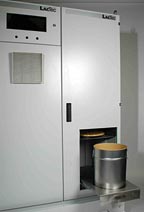
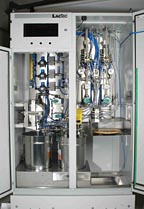
Using Pigs for the Delivery Of Limited Paint Volumes
For many paint system operators, most notably over-the-road truck manufacturers and some other specialty vehicle suppliers, the need to apply a continuous sequence of one-time custom colors causes very large paint losses. Typically, it may require 15 to 18 gal of paint to fill a paint circulation line, whereas only 2 to 4 gal of paint are actually applied to the vehicle. Because many of these colors are used only one time, the 10 or 15 gal remaining in the circulation system when the job is completed are simply wasted. With some hundreds of custom color jobs each week, these losses quickly become a very significant factor in the total paint system operating costs, and can radically increase the per-vehicle applied cost.
Pigging technology developed in Europe in recent years addresses the need to reduce these losses. The basic concept is to load only the minimum required volume of paint into the circulation line, inject a pig behind it, and use the pig to send that limited-volume "slug" of paint down the line to the various paint application stations, in a sense "tracking" the job as it progresses through the paint booth. For that reason, these systems are commonly known as tracking paint systems. The pressure required to supply the paint at each application station is provided by compressed air behind the pig. Ideally, the volume of paint remaining in the circulation line is nearly exhausted just as the painting process for any given target is completed.
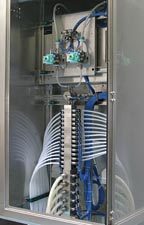
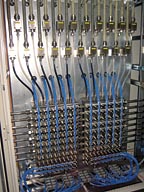
Using Pigs to Recover Paint in the Application Lines
Typical of many systems in operation today, the paint in the fluid supply line between the color changer and the applicator is lost during each color change. With very frequent color changes and long lengths of tubing between the color changer and applicator, such as when a robot is mounted on an X-rail, these losses can quickly become very considerable. One common solution has been to mount the color changer in or on the robot arm, thereby reducing to a minimum the length of the fluid supply tubing and the volume of paint lost on each color change. While this solution is perfectly viable, it has its limitations. Mounting the color changer in the robot arm requires many more tubes to be run out to the robot, requires entry into the booth each time some color changer maintenance routine is required and, by the limitation of the space available in or on the robot, imposes a cap on the number of colors that can be accommodated in this manner. For many manufacturers, such as Tier 1 plastics suppliers, which may have color pallets containing hundreds of different colors, this traditional solution imposes severe operating restrictions that are not easily overcome and limit the opportunities for reducing material losses during the color change process.European pigging technology has been developed to address this problem. Once again, the basic concept is simple. If the paint in the tubing between the color changer and the applicator can be recovered during each color change sequence, then the length of the tube is no longer that critical and the color changers can be located back outside the booth. The concept behind recovering this paint is to use a pig to push the paint in the tubing back into the paint circulation system at the start of a color change sequence. In this case, the pig resides in a catcher out at the applicator during normal painting operations. At the beginning of each color change procedure, the pig is injected into the paint supply tubing and is forced back toward the color changer under high pressure. With the color changer valve held open, this forces the otherwise lost paint back into the circulation system and saves it for future use. Paint supply tubing recovery pigging permits the location of the color changers to be outside the booth while avoiding the loss of high volumes of paint that would otherwise occur, thereby avoiding the limitations and penalties of placing the color changer at the robot arm. This technology has been applied to both automatic and manual paint applicators, guns and bells.
While the concept is simple, once again the realization of it can be quite complex. Push-back, flushing, cleaning and re-filling are all automatic. Circuits that can bypass gear pumps or pressure regulators during push-back are commonly required. Special tubing must be used to withstand the increased back pressures while maintaining the proper dimensions to ensure effective contact between the tubing wall and the pig. Typically, to meet the commonly short effective color change time requirements of just a few seconds, these systems are of an A/B configuration. For waterborne paints systems, special piggable high-voltage isolation systems have been developed. As with the other advanced pigging technologies, these systems are typically fully integrated with FIS, with data acquisition monitoring pig run times, material usages, viscosity changes and preventive maintenance factors. Typical pig lifetimes in these applications have stretched into the thousands of cycles, again depending on system configuration and paint characteristics.
Applications
The pigging technologies described above have been utilized in Europe in the full range of paint material applications: Solvent-borne, waterborne and plural-component paints. In some cases, all three paint types have been successfully applied via pigging systems to a single applicator in highly automated and highly paint-usage efficient applications. In other cases, all three pigging technologies described here operate in tandem in systems that represent the true state of the art in modern painting facilities. At another painting facility, the paint booth layout has permitted the placement of all the pigging and color changing functions and equipment in one centralized location, resulting in one complex "matrix" color changer with piggable paint supply tubing emanating outward to various booth locations in a spider configuration.All possible permutations in system configurations and operating modes that are now feasible through the use of advanced pigging technologies have not yet been fully explored. New sets of requirements for automatic pigging technology are constantly arising. The suppliers of advanced pigging systems in Europe are frequently responding to the engineering challenges with new applications and new equipment that constantly expand the horizons for this technology. With advancements in other paint system efficiency related technologies, such as first pass transfer efficiency, now coming in very small increments, the considerable paint savings that result from the increasingly widespread application of advanced pigging systems represents one of the most important avenues for paint system operating cost savings that can be identified today. And with many of these systems now in successful operation stretching out to four and five years, the benefits and reliability of these applications are now beyond question. As awareness of advanced pigging technologies reaches North American shores, it is apparent that many manufacturing facility managers will soon start to realize the savings potential that these technologies can bring to their own plants.
Looking for a reprint of this article?
From high-res PDFs to custom plaques, order your copy today!




